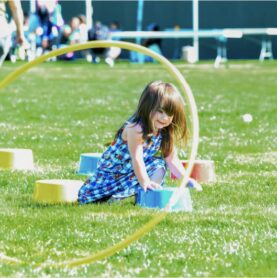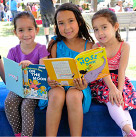Play-Based Learning: Why Play Matters in Early Childhood Education
Children develop at a rapid rate from birth through adolescence. All children learn and grow in their own unique way but play is a great way to introduce children to new concepts and create a love for learning. Play-based learning recognizes the natural curiosity within children and capitalizes on those instincts with hands on discovery and exploration. This approach to learning empowers children to problem solve, ask questions, and investigate.
Understanding Play-Based Learning
Play-based learning is a child-driven approach involving exploration, discovery, and problem-solving through play. Though children have been learning through play throughout human history, this concept as a teaching tool has been growing in popularity thanks to its observable positive impact.
Why Play Is Essential for Early Childhood Development
When parents and caregivers support a child’s purposeful play, children not only develop essential academic skills but also improve crucial social, emotional, and cognitive skills.
Through play, children build and strengthen socio-emotional and cognitive skills, according to research from Texas Christian University. Children at play have agency (control over their own actions) and feel socially and emotionally safe. They express themselves freely, trying out different behaviors or ideas, without fear or anxiety.
Cognitive and Problem-Solving Skills
Cognitive skill-building is an important feature of child development as it helps a child understand the “rules,” so to speak, of engaging with others and their environment.
When a child engages in make believe acting, where they create a scenario with real or non-real (imaginary) characters, they are building upon cognitive skills. Creating a situation and responding to the scenario and characters involved helps a child’s brain reinforce pathways of communication, problem solving, and expected outcomes. TCU research found that “when children create imaginary situations, they increase their ability to follow internal ideas and social rules rather than impulses, and can practice activities they are too young to perform in real life.”
Researchers at Harvard agreed, noting “Play is an important part in any child’s life. But games and play are much more than just keeping a child occupied: The act of play is an essential part of a child’s overall development.” They went on to suggest that playful interactions with adults help babies develop executive function skills. Conversely, older children need “unstructured play and down time as their commitments like homework, sports, and clubs complicate their growing lives.”
Try these cognitive skill builders:
- Puzzle-solving
- Storytelling with voices and characters
- Memory games
- Reading
- Building blocks
- Nature exploration
- Counting
- Music and sensory play
Language and Communication Development
Pretend play and storytelling enhance vocabulary and communication skills. By pretending to go to the grocery store or a doctor’s appointment, for instance, your child can draw from a previous experience and create new conversations around them. In these particular scenarios, the caregiver may pretend to be the customer while the child is the cashier at the grocery store. Or the child is the doctor and the caregiver is the patient. Engage with the child with genuine, related communication: “Hello, I’d like to buy these items. How much will that be?”
By asking questions, you encourage the child to think critically and respond in a thoughtful way. For example: “Are these apples sweet?” “What can I make with these noodles?”
Use a vocabulary that’s suitable to the child’s development but challenge them with new words and phrases to help them grow.
Social-Emotional Learning
Collaborative and imaginative play teaches empathy, cooperation, and conflict resolution. Your child may not be able to imagine, unprompted, a situation that requires one of these three tenants. But you can initiate the scenario, for example: “We’re both on a spaceship but we are lost and don’t know how to get back to earth.” Or “You’re the teacher and I forgot to do my homework.” Children will observe, take note of, and even replicate behaviors or words you use in the interaction. This make collaborative play a great time to exhibit positive conversations and interactions. Use props, like a play kitchen with faux food or a laundry basket, to make the experience more interactive.
Motor Skill Development
Fine motor and gross motor are important in every day life and children begin learning them from the moment they roll over or lift their head. These two skills are often lumped together as physical skills but each is uniquely important.
Gross motor skills are important to everyday physical activities like walking, running, throwing, lifting, and kicking. Gross motor abilities also form the basis for fine motor skills and relate to body awareness, reaction speed, balance and strength.
Fine motor skills are the precise movements of the hands, fingers, and wrists that enable us to complete everyday tasks. These movements involve the coordination of small muscles with the brain and nervous system.
Though each child develops at their own pace and in their unique way, the Children’s Hospital Gross outlines motor development milestones guidelines for children ages 0 to 5 years:
Newborn to 2 months
- Turns head to both sides while on back
- Lifts head and able to turn to both sides while on belly
- Head lag with pull to sit
- Kicking both legs and moving both arms equally while on back
- Performs tummy time on floor regularly
3-4 months
- Raises head in line with trunk when pulled to sit
- Pushes up on forearms and turn head side to side while on belly
- Tolerates tummy time well
- Rolls from belly to back
5 months
- Rolls from back to belly
- Brings feet to mouth laying on back
- Pushes up on hands with arms extended while on belly
- Pivots in a circle while on belly to each side
6-8 months
- Sits alone
- Reaches for toys to play in sitting
- Catches self with loss of balance in sitting
- Crawls on belly
9-11 months
- Moves between laying down and sitting upright without help
- Crawls on hands and knees
- Pulls to a standing position with one foot leading
- Cruises around furniture
- Walks with two hands held
11-12 months
- Walks with one hand held
- Stands alone for a few seconds
13-14 months
- Crawls up stairs
- Stands up from the floor without support
- Walks alone well
- Squats and stands back up without holding onto support
15-18 months
- Walks up stairs with hands or rails to help
- Crawls down the stairs (on belly, feet first)
- Can run, though falls easily
- Kicks a ball forward
2 years
- Walks and runs fairly well
- Jumps in place with both feet off the ground
- Walks up and down stairs alone
- Kicks a ball with either foot
3 years
- Balance on one foot for a few seconds
- Jump forward 10-24 inches
- Catches a large ball
- Rides a tricycle
By 4 years
- Can run, jump and climb well, is beginning to skip
- Hops proficiently on one foot
- Can do hopscotch
- Catches a ball reliably
- Begins somersaults
By 5 years
- Skips on alternate feet and jump rope
- Begins to skate and swim
- Rides bicycle with/without training wheels
- Climbs well
Here are some activities to boost fine and gross motor skills:
Indoor:
- Infants/toddlers:crawling and walking over various surfaces such as creating obstacles with pillows and blankets; sitting with support at torso on an exercise ball, mommy/daddy and me classes (yoga, tumbling, swimming)
- Children: bounce house play, jump rope activities, yoga, dance, gymnastics, cheerleading
Outdoor:
- Infants/toddlers: mommy/daddy and me swim classes; water play in buckets or playing at water tables; infant/toddler swings or slides at the playground; obstacles over various surfaces such as gravel, grass
- Children: swimming, sprinkler water play, water parks, Marco polo, ice skating, snow tubing, sledding, roller skating, skateboarding, playgrounds, riding scooters, tricycle and bicycle riding, hiking, jumping and hopscotch activities, soccer, baseball, swinging
The Main Elements of Play-Based Learning
Successful play-based learning has a couple of key elements: child-directed, enjoyable, unstructured, process oriented, and make believe.
Child-Directed
Self-selected refers to an activity that the child chose for themselves and for a length of time that they choose. Freedom of choice is an important factor in the child’s attitude toward the experience.

Unstructured & Flexible
It’s also important not to create rigid rules around the play. Avoid setting times and guidelines around the play, such as “we only play after lunch” or “we only play inside.” Be flexible in the time and location of play, which may impact a child’s willingness or interest in play.
When children co-construct their learning with their teachers and peers, they apply it to their own lives making meaningful, personal discoveries as they progress towards learning goals, according to the University of New Hampshire’s College of Health and Human Services.
Process-Focused
The focus is on the journey of play and exploration, rather than a specific outcome. Process oriented refers to the experience as a vehicle for children to develop new skills while also transferring knowledge and skills across content areas through natural, authentic, and meaningful use and integration, the UNH reports.
Creative & Imaginative
Make believe play encourages children to let their creativity and imagination flow. When children can think freely, it builds upon their natural curiosity, to explore, discover, and make sense of the world around them. If you and the child are pretending to be customer and clerk at a grocery store and the child tells you, “the candy bar is free,” don’t tell them they can’t do that because it’s not realistic. The point of play is to think freely and be creative, not to portray a true-to-life situation that follows a specific playbook.
Types of Play-Based Learning (Free vs. Guided Play)
In supporting children with play-based learning, caregivers can use two different approaches” – free or guided play. These two styles promote learning in different, but effective ways.
Free Play
This style of play is more spontaneous and specifically allows children to pursue their own interests and engage in unstructured activities.
Guided Play
In this style, the caregiver plays a supportive role in enhancing learning, such as providing materials, and posing thoughtful questions. An analysis by the Association for Psychological Science found that “enhanced discovery” (analogous to guided play) led to better outcomes than other types of learning.
Examples of Simple Play-Based Learning Activities
Here are some engaging and actionable examples parents and caregivers can easily replicate at home or educators in the classroom.
- Sensory bins: Create individual buckets of textured items that your child can investigate. Put marbles in one bucket, fill another with cotton balls, soapy water in a third bucket, and one with pennies. Encourage the child to explore the buckets and ask them what they feel and see. This experience promotes curious discovery and exploration, as well as communication about their perception.
- Simple science activities (floating/sinking): Teach a child about buoyancy with simple household objects. Fill a bucket with water and collect items of varying sizes and shapes, such as a rock, balloon, leaf, and a fork. Tell your child to select an item and ask if they think it will sink or float. Ask why they predict that. Then encourage your child to drop the item in the water. Observe what happens together then discuss it.
- Creative arts (finger painting, collage): Place paints, a cup of water, brushes and a canvas or paper on the table. Invite your child to make art with you. Suggest some images, like “show me what you’re feeling today” or “paint what you will be and do in the future.”
- Music and movement: Ask your child to pick some songs. Play the music and encourage your child to dance and be silly.

Common Concerns About Play-Based Learning
Some caregivers worry that play-based learning isn’t structured enough or fails to properly educate children on core concepts. However, play is a useful and impactful tool in a child’s early learning because it not only motivates the child to explore their curiosity, but the positive feelings attached to play can encourage ongoing learning.
Will play-based learning prepare my child for kindergarten?
Play-based learning promotes social-emotional readiness and academic curiosity among children. By making learning fun, caregivers can inspire a love for learning.
How can I know my child is actually learning?
Learning progress is evident through improved communication, problem-solving skills, and positive attitudes towards school. As your child participates in activities designed to promote language, motor skills, and social-emotional skills, you will see improvements in their early development. Each time you return to a play activity, you should expect to see an increase in the level of complexity and/or involvement by the child.
Children’s Playgroups: Enhancing Early Learning and Social Skills
Playgroups are valuable social and developmental opportunities. These sessions reinforce skills mentioned earlier (social, cognitive, motor, language). CCRC offers virtual an in person playgroups designed to foster connection among caregivers while promoting early learning through play. The playgroups not only support children in early learning, they assist with professional support and community-building benefits for caregivers.
Check out the CCRC Events Calendar for dates.
Tips for Parents and Educators
There are many ways to inspire play-based learning with children.
- Provide open-ended materials (blocks, art supplies)
- Ask children open-ended questions during play
- Allow sufficient unstructured time daily
- Rotate toys and materials regularly to sustain interest
- Participate occasionally without directing play
- Visit our Parents page for additional resources.
Discover the Joy of Learning Through Play
Play-based learning is highly beneficial for children who may be more encouraged and motivated to learn through curiosity-fueled exploration. Help children develop a love for learning by making the experience fun. Introduce them to new activities, art projects, and imaginary situations to inspire intrigue. As a child feels, smells, and sees the world around them, they develop a new understanding of their surroundings and the people they encounter. Though you won’t see their progress through a gradable test, caregivers should expect to witness their child’s development through the confidence exhibited by children as they play and explore. Check out CCRC’s free playgroups, family play days, and story times for engagement opportunities near you.



